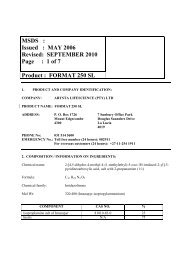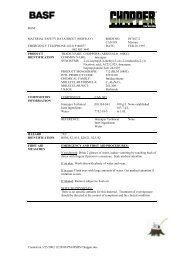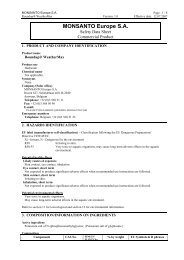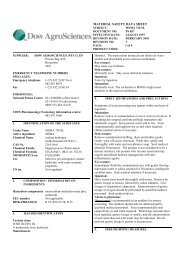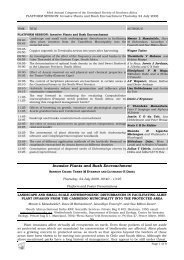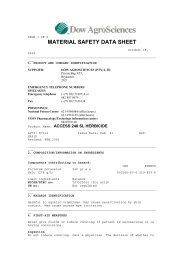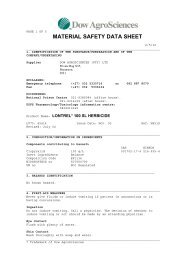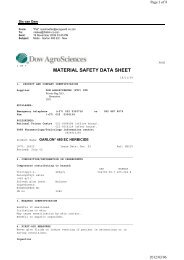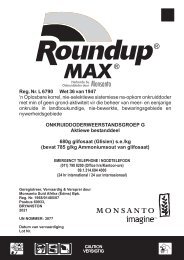MSDS Glyphosate 360 - Bush Encroachment
MSDS Glyphosate 360 - Bush Encroachment
MSDS Glyphosate 360 - Bush Encroachment
You also want an ePaper? Increase the reach of your titles
YUMPU automatically turns print PDFs into web optimized ePapers that Google loves.
MATERIAL SAFETY DATA SHEET<br />
GLYPHOSATE <strong>360</strong><br />
Reproductivity:<br />
Reproductive changes in test animals only occur at very high doses.<br />
It is unlikely that glyphosate would produce effects in humans.<br />
12. ECOLOGICAL INFORMATION<br />
Degradability:<br />
<strong>Glyphosate</strong> is moderately persistent in soil, with estimated half-life of<br />
47 days. Microbes are primarily responsible for breakdown.<br />
<strong>Glyphosate</strong> is strongly adsorbed to suspended organic and mineral<br />
matter in water, and broken down primarily by microbes. Half-life<br />
ranges from 12 days to 10 weeks.<br />
Mobility:<br />
The product is practically immobile. It is strongly absorbed to most<br />
soils. It does not leach appreciably, and has low potential for runoff.<br />
Accumulation:<br />
The product shows little or no tendency to bioaccumulate and poses<br />
no long term threat to wildlife.<br />
ECOTOXICOLOGY:<br />
Birds: Slightly toxic.<br />
LC50 (5-day diet): Mallard duck: > 4500 mg/kg diet<br />
Reg nr.: 2004/020524/07<br />
Do not re-use the empty container for any other purpose but destroy<br />
it by perforation and flattening and bury in an approved dump site.<br />
Prevent contamination of food, feedstuffs, drinking water and eating<br />
utensils.<br />
Comply with local legislation applying to waste disposal.<br />
14. TRANSPORT INFORMATION<br />
UN NUMBER: 3082<br />
Road Transport ADR/IRD:<br />
Class: 9<br />
Packing group:<br />
Shipping name:<br />
Maritime Transport IMDG/IMO:<br />
Class: 9<br />
Packing group: III<br />
Shipping name:<br />
Considered a Marine Pollutant.<br />
III<br />
Environmentally hazardous substance,<br />
liquid, N.O.S. (herbicide - glyphosate)<br />
Environmentally hazardous substance,<br />
liquid, N.O.S. (herbicide - glyphosate)<br />
Bobwhite quail: > 4500 mg/kg diet<br />
Fish: Not toxic.<br />
15. REGULATORY INFORMATION<br />
LC50 (96 hours): Bluegill sunfish: > 1000 mg/λ Symbol:<br />
N<br />
Trout:<br />
> 1000 mg/λ Indication: Environmentally dangerous substance.<br />
Fathead minnows 97 mg/λ Risk phrases:<br />
Due to surfactant, GLYPHOSATE <strong>360</strong> is moderately toxic to R 36 Irritating to eyes.<br />
fish.<br />
Bees: Not toxic.<br />
R 52<br />
R 54<br />
Harmful to aquatic organisms.<br />
Toxic to flora.<br />
LD50 oral & dermal:<br />
> 0.1 mg/bee Safety phrases:<br />
Daphnia:<br />
LC50 (48 hours):<br />
930 mg/λ<br />
S 2<br />
S 2425<br />
Keep out of reach children.<br />
Avoid contact with skin and eyes.<br />
Earthworms:<br />
S 36/37/39 Wear suitable protective clothing, gloves and<br />
LC50 (14 days): Eisenia foetida: > 5000 mg/kg soil<br />
eye/face protection.<br />
Other Beneficial organisms:<br />
No effect on carabid beetles. Harmless to slightly harmful to green<br />
lacewing, parasite species, mites / spiders and insects. Moderately<br />
harmful to Bembidion lampros.<br />
S 45<br />
S 61<br />
In case of accident or if you feel unwell, seek<br />
medical advice immediately (show the label where<br />
possible).<br />
Avoid release to the environment.<br />
13. DISPOSAL CONSIDERATION<br />
16. OTHER INFORMATION<br />
Pesticide disposal:<br />
Open dumping or burning of this pesticide is prohibited Waste<br />
resulting from the use of this product that cannot be reused or<br />
reprocessed. Never pour untreated waste or surplus products into<br />
public sewers or where there is any danger of run-off or seepage<br />
into water systems. Do not contaminate rivers, dams or any other<br />
water sources with the product or used containers.<br />
Comply with local legislation applying to waste disposal.<br />
Container disposal:<br />
Emptied containers retain vapour and product residues. Observe all<br />
labelled safeguards until container is destroyed.<br />
TRIPLE RINSE empty containers in the following manner: Invert the<br />
empty container over the spray or mixing tank and allow to drain for<br />
at least 30 seconds after the flow has slowed down to a drip.<br />
Thereafter rinse the container three times with a volume of water<br />
equal to a minimum of 10 % of that of the container. Add the<br />
rinsings to the contents of the spray tank before destroying the<br />
container in the prescribed manner.<br />
Packaging and Labelling:<br />
Packed in 200 mλ, 500mλ & 1, 2, 5, 10, 20 and 25 λ fluorinated<br />
plastic containers and labelled according to South African<br />
regulations and guidelines.<br />
Disclaimer:<br />
The information on this sheet is not a specification; it does not<br />
guarantee specific properties. The information is intended to provide<br />
general guidance as to health and safety based upon our knowledge<br />
of the handling, storage use of the product. It is not applicable to<br />
unusual or non-standard uses of the product nor where instructions<br />
or recommendations are not followed.<br />
All information is given in good faith but without guarantee in respect<br />
of accuracy, and no responsibility is accepted for errors and<br />
omissions or the consequence thereof.<br />
END OF DOCUMENT<br />
Compiled: May 2002 Reviewed: December 2005<br />
Effective Date: May 2002 Document no: 0023TP<br />
Revision no: 1 (December 2005) Page 3 of 3



